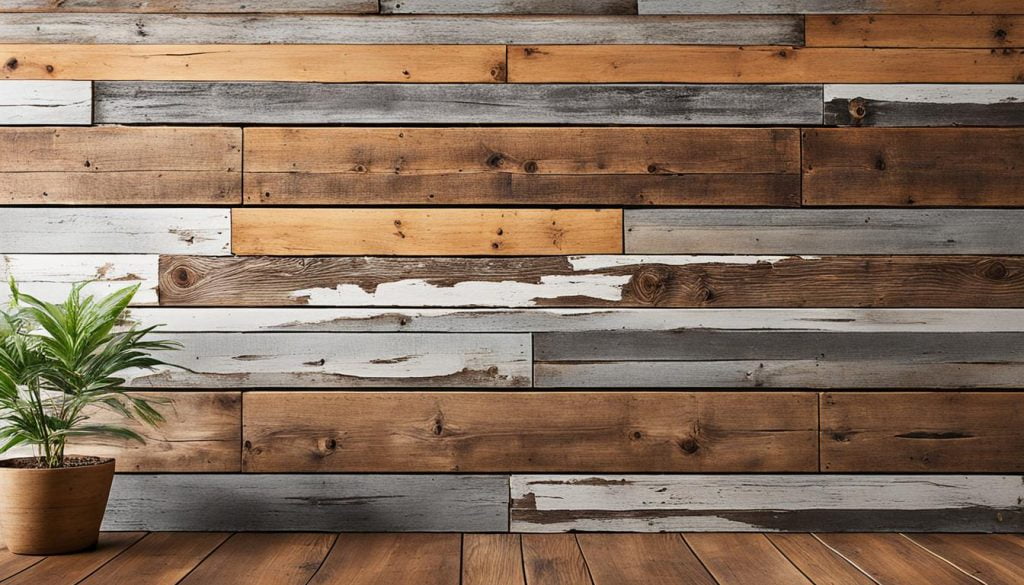Did you know that the construction industry is responsible for a staggering amount of waste and carbon emissions? In fact, it is estimated that construction and demolition activities generate over 500 million tons of waste annually in the United States alone. This alarming statistic highlights the urgent need for eco-friendly construction materials that can reduce our environmental impact and promote sustainable living.
Key Takeaways:
- Using recycled and sustainable materials in construction is essential for reducing waste and carbon emissions.
- Eco-friendly building materials contribute to energy savings and cost efficiency.
- Cob, recycled steel, sheep’s wool, reclaimed wood, cork, straw bales, bamboo, recycled plastic, AshCrete, and Ferrock are some examples of environmentally friendly construction materials.
- Each material offers unique benefits in terms of insulation, strength, durability, and resilience.
- A balanced approach to using recyclable renewables can help achieve sustainability in the construction industry.
Cob – An Eco Friendly Natural Building Material
When it comes to eco-friendly construction, one material that stands out is cob. Cob is a mixture of subsoil, water, and fibrous organic material like straw or manure. It is a natural and sustainable building material that has been used for centuries in various cultures. Cob offers numerous benefits and is an excellent alternative to traditional construction materials.
Easy to Use and Flexible
Cob is a versatile material that allows for creative freedom in construction. It is easy to work with and can be molded into any shape or form. Builders can sculpt cob walls, arches, and even intricate designs. This flexibility allows for unique and personalized structures.
Excellent Insulation Properties
Cob houses offer exceptional insulation properties, making them energy-efficient and environmentally friendly. The thick cob walls provide natural insulation, keeping the interior cool in hot weather and warm during colder months. This insulation reduces the need for artificial heating and cooling systems, resulting in lower energy consumption and cost savings.
Eco-Friendly and Sustainable
Cob is an eco-friendly choice for construction due to its minimal environmental impact. It is made from natural, locally available materials and requires significantly less energy to produce compared to conventional building materials. Cob also has a long lifespan and can be easily repaired or modified, reducing waste and promoting sustainability.
“Cob is a perfect example of how sustainable architecture can create harmony between human habitation and the natural environment.” – Architectural Digest
Natural Insulation
In addition to its thermal insulation properties, cob also provides excellent sound insulation. The dense composition of cob walls absorbs and dampens sound waves, creating a quieter and more comfortable living environment.
Cost-Effective
Cob construction can be cost-effective, especially for owner-builders. The materials needed for cob construction are often readily available and inexpensive. Additionally, the simplicity of the construction process can help reduce labor and construction costs.
Overall, cob is a sustainable, eco-friendly, and aesthetically pleasing natural building material. Its insulation properties, flexibility, and affordability make it an attractive option for those looking to build environmentally friendly homes.
Recycled Steel – A Strong and Durable Option
When it comes to construction materials, recycled steel is a game-changer. Not only is it environmentally friendly, but it also offers exceptional strength and durability. By opting for recycled steel, you contribute to a sustainable future while benefiting from a highly reliable material.
One of the most remarkable qualities of recycled steel is its ability to maintain its properties even after recycling. This makes it an ideal choice for construction projects where strength and longevity are key considerations. Whether it’s for structural purposes or reinforcements, recycled steel provides the necessary robustness to withstand various elements.
Furthermore, using recycled steel helps to conserve energy and reduce greenhouse gas emissions. By utilizing this eco-friendly material, you actively contribute to the reduction of carbon footprint, making it a sustainable choice for builders and developers alike.
To better understand the impact of recycled steel, let’s take a closer look at some of its key benefits:
- Energy-saving: Recycled steel production requires significantly less energy compared to the manufacturing of new steel. This helps to conserve valuable resources and reduce the demand for energy-intensive processes. Choosing recycled steel is a smart energy-saving solution.
- Strong and durable: As mentioned earlier, recycled steel maintains its strength and durability even after being recycled. It is resistant to corrosion, fire, and pests, making it an ideal choice for long-lasting construction.
- Environmentally friendly: By using recycled steel, you are actively participating in the circular economy by reducing waste and promoting resource efficiency. This sustainable approach contributes to a healthier and greener planet.
When considering construction materials, it’s crucial to prioritize sustainability without compromising on quality. Recycled steel offers the perfect balance, providing both environmental benefits and structural integrity.
“Recycled steel is a strong and durable option that not only meets construction requirements but also aligns with the principles of sustainability. Its environmentally friendly nature and energy-saving properties make it a wise choice for builders who prioritize the long-term well-being of our planet.”
Make a conscious decision today and choose recycled steel for your next construction project. Together, we can build a sustainable future.
| Benefits of Recycled Steel |
|---|
| 1. Energy-saving |
| 2. Strong and durable |
| 3. Environmentally friendly |
Sheep’s Wool – A Natural Insulator
When it comes to insulating your home, sheep’s wool is a sustainable and eco-friendly choice that offers remarkable benefits. This natural material is not only readily available but also acts as an excellent insulator, helping you save energy and reduce your carbon footprint.
Sheep’s wool is a renewable resource, making it an environmentally friendly option for insulation. It is sourced from sheep, which are shorn annually, ensuring a continuous supply without harming the animals. By using this natural material, you contribute to sustainable practices and support the well-being of sheep populations.
Sheep’s wool is a renewable and eco-friendly material that acts as an excellent home insulator.
One of the key advantages of sheep’s wool is its ability to trap air in millions of tiny pockets. This trapped air provides exceptional insulation, keeping your home warm in winter and cool in summer. By reducing heat transfer through walls, ceilings, and attics, sheep’s wool insulation helps maintain a comfortable indoor environment while reducing the need for excessive heating or cooling.
Sheep’s wool also offers sound-absorbing properties, creating a quieter and more peaceful living space. It dampens sound vibrations, minimizing noise pollution from both inside and outside your home. This natural insulation material contributes to a serene and tranquil ambiance, promoting overall well-being.
Using sheep’s wool as insulation is not only energy-saving but also helps reduce carbon emissions. By minimizing heat loss or gain, you consume less energy for heating and cooling, resulting in lower utility bills. Additionally, sheep’s wool insulation is naturally fire-resistant, providing added safety and peace of mind.
Sheep’s wool is easy to source and install. It comes in various forms, including rolls or batts, which can be easily cut and fitted into your desired spaces. This versatility allows for hassle-free installation, making it a preferred choice for both professional contractors and DIY enthusiasts.
To summarize, sheep’s wool acts as a natural insulator that offers significant energy-saving benefits, reduces carbon footprint, and promotes an environmentally friendly lifestyle. Its insulation properties, along with sound absorption and safety features, make it a practical and sustainable choice for eco-conscious homeowners.
Benefits of Sheep’s Wool Insulation:
- Natural and renewable insulation material
- Traps air in tiny pockets, providing excellent insulation
- Reduces heat transfer and energy consumption
- Enhances sound absorption and promotes a quieter living environment
- Easy to source and install
- Naturally fire-resistant, ensuring safety
Choose sheep’s wool insulation for an energy-efficient and environmentally friendly home.
Reclaimed, Recycled or Sustainable Wood – Aesthetically Pleasing and Eco-friendly
When it comes to eco-friendly construction, reclaimed, recycled, or sustainable wood is a top choice. Not only does it create a natural and soothing environment, but it also contributes to a more sustainable future. Let’s explore the benefits and features of these environmentally conscious wood options.
Reclaimed Wood
Reclaimed wood is salvaged from old buildings, barns, and other structures, giving it a unique character and history. By repurposing this wood, we prevent it from ending up in landfills and reduce the need to cut down new trees. Reclaimed wood can be used for various applications, including flooring, paneling, and furniture, creating a rustic and vintage look. With its distinct textures and colors, reclaimed wood adds warmth and charm to any space.

Recycled Wood
Recycled wood is sourced from post-consumer or industrial wood waste, such as pallets, crates, and construction debris. It undergoes a process of cleaning and refurbishment, transforming it into a viable material for construction. Using recycled wood reduces the demand for new timber and minimizes the environmental impact associated with logging and processing. This sustainable option still retains the natural beauty and durability of wood, making it suitable for various applications.
Sustainable Wood
Sustainable wood comes from responsibly managed forests that prioritize proper logging techniques and reforestation efforts. These forests ensure the long-term health and vitality of the ecosystem while also meeting timber demands. By choosing sustainable wood, you support the preservation of natural habitats and promote a more balanced and sustainable approach to forestry. Sustainable wood offers the beauty and strength of traditional timber while minimizing the environmental impact.
Eco-friendly Architecture and Natural-looking Floors
Reclaimed, recycled, and sustainable wood not only contribute to eco-friendly architecture but also offer natural-looking floors that enhance the overall aesthetic appeal of a space. The warmth, texture, and natural variations in wood create a timeless and inviting atmosphere. Whether you prefer sleek and modern designs or rustic and traditional styles, wood floors bring a sense of harmony and beauty to any interior.
By choosing reclaimed, recycled, or sustainable wood, you actively participate in the movement towards more eco-friendly construction practices. Not only do you create a unique and visually appealing space, but you also make a positive impact on the environment. Let’s embrace the beauty of wood while preserving the planet for future generations.
Cork – Resilient and Sustainable
Cork is a resilient and sustainable material that is sourced from cork oak trees. With its unique properties, cork has become a popular choice in various applications within the construction industry. From cork ceiling panels to acoustic wall coverings and flooring, cork offers both aesthetic appeal and environmental benefits.
One of the key advantages of using cork is its resilience. Due to its cellular structure, cork can withstand pressure and bounce back to its original shape. This makes it an ideal material for areas with high foot traffic, as it can effectively absorb impact and reduce noise.
In addition to its resilience, cork is also moisture-resistant. Its natural waxy substance, known as suberin, acts as a barrier against moisture and prevents the growth of mold and mildew. This makes cork suitable for environments that require moisture control, such as bathrooms and kitchens.
Cork’s eco-friendly properties make it a sustainable choice for interior design. As a renewable resource, cork oak trees can be harvested every nine years without causing permanent damage to the environment. The harvesting process involves stripping the outer bark, allowing the tree to regenerate. This sustainable practice ensures the longevity of cork production while preserving the natural habitat.
Furthermore, cork’s ability to absorb vibrations makes it an excellent choice for minimizing noise pollution. This quality is particularly beneficial in office spaces, schools, and residential buildings, where a quiet and peaceful environment is essential.
By incorporating cork into interior design, not only do you create a visually appealing space, but you also contribute to the fight against global warming. Cork oak trees absorb large amounts of carbon dioxide, making them a valuable ally in mitigating climate change.
“Cork is a versatile material that combines aesthetics with sustainability. Its resilience, moisture resistance, and eco-friendly attributes make it a top choice for a wide range of applications.”
With its numerous benefits and sustainable properties, it’s no wonder that cork has gained popularity in the world of interior design. Whether you’re looking to add a touch of elegance to your space or seeking sustainable materials, cork proves to be a resilient and eco-friendly option.
Straw Bales – Sustainable Insulation
When it comes to sustainable construction, using straw bales as insulation material is an excellent choice. Not only are straw bales a renewable resource, but they also offer exceptional insulation properties, contributing to energy efficiency and reduced heating costs. Straw bales can be used to insulate walls, attics, and ceilings, providing excellent temperature stability and a comfortable living environment.
One of the key advantages of straw bales is their high thermal resistance, which helps minimize heat transfer and maintain a consistent indoor temperature. This natural insulation material also has the ability to absorb moisture, preventing condensation and mold growth. Additionally, straw bales have excellent sound absorption properties, creating a quieter and more peaceful living space.
Straw bales can be easily compressed into panels, making it convenient for insulated cladding. These compressed straw panels are 100% recyclable and biodegradable, minimizing the environmental impact. Utilizing straw bales as insulation not only reduces the demand for traditional construction materials but also supports sustainable agricultural practices. By incorporating straw bales into your construction project, you are actively contributing to a more eco-friendly and energy-efficient building.
Take a look at the table below for a quick overview of the benefits of using straw bales as insulation:
| Benefits of Straw Bale Insulation |
|---|
| Renewable and Sustainable |
| Excellent Thermal Resistance |
| Moisture Absorption |
| Superior Sound Absorption |
| Easy Panel Compression |
| Recyclable and Biodegradable |
Straw Bale in Real-World Applications
Straw bale construction has gained popularity in eco-friendly and sustainable architecture. For example, Archiblox, an Australian design and construction firm, specializes in prefabricated modular homes that feature straw bale insulation. These innovative homes promote energy efficiency and embrace sustainable living without compromising on aesthetics or comfort.

Implementing straw bale insulation in your construction project not only provides a sustainable solution for insulation but also supports local farmers and reduces the environmental impact. The benefits of using straw bales go beyond energy efficiency, creating a healthier and more environmentally conscious living space.
Bamboo – Fast-growing and Strong
When it comes to eco-friendly construction materials, bamboo stands out as a renewable resource that offers numerous benefits. Its rapid growth and exceptional strength make it an excellent choice for sustainable building practices.
Bamboo is a type of grass that grows incredibly fast, reaching maturity within just a few years. This makes it a highly renewable resource that can be harvested without causing long-term damage to the environment. Unlike traditional timber, which can take decades to mature, bamboo can be consistently replenished, making it a sustainable alternative.
But what truly sets bamboo apart is its remarkable strength. Despite its lightweight appearance, bamboo has a fibrous structure that gives it exceptional tensile strength. It can surpass the strength of many traditional construction materials, including steel, making it an ideal choice for various applications.
Furthermore, bamboo is 100% biodegradable, emphasizing its eco-friendly nature. Unlike synthetic materials that can take centuries to decompose, bamboo naturally breaks down and returns to the environment without causing pollution or harm.
With its fast-growing nature, strength, and eco-friendly qualities, bamboo has become an increasingly popular material in the construction industry. From flooring and furniture to structural elements, bamboo offers a sustainable and aesthetically pleasing option for eco-conscious builders and homeowners.
The Advantages of Bamboo in Construction
- Fast-growing and highly renewable resource
- Exceptional strength and durability
- Biodegradable and eco-friendly
- Versatile applications in various construction projects
- Provides a natural and visually appealing aesthetic
| Advantages of Bamboo | Traditional Construction Materials |
|---|---|
| Fast-growing and renewable | Slow-growing and limited availability |
| High tensile strength | Variable strength depending on material |
| Biodegradable and eco-friendly | Non-biodegradable and environmentally harmful |
| Lightweight yet durable | Heavy and cumbersome |
Whether used as a primary building material or incorporated into architectural elements, bamboo offers eco-friendly construction solutions without sacrificing durability or aesthetic appeal. Its rapid growth, strength, and sustainable qualities make it a valuable resource in the pursuit of greener and more sustainable construction practices.
Recycled Plastic – Durable and Environmentally Friendly
Recycled plastic is a durable material that offers numerous benefits in construction. It not only helps reduce waste but also contributes to a circular economy by giving plastic a new life.
One of the advantages of using recycled plastic is its sound retention properties. It can effectively dampen noise, making it ideal for applications where noise reduction is necessary, such as sound barriers on highways or walls in noisy environments.
Furthermore, utilizing recycled plastic in construction is an excellent way to reduce waste. By repurposing plastic that would otherwise end up in landfills or oceans, we can help mitigate the environmental impact of plastic pollution and work towards a more sustainable future.
“By using recycled plastic, we can contribute to a circular economy and reduce the amount of plastic in landfills and oceans.”
Not only is recycled plastic an environmentally friendly option, but it is also a durable material that can withstand the rigors of construction. It is resistant to rot, decay, and pests, making it a long-lasting choice for various applications.
When considering eco-friendly alternatives in construction, recycled plastic offers a viable solution. Its durability, sound retention properties, and waste reduction benefits make it a sustainable choice that aligns with the principles of green building.
Example of Recycled Plastic Application
An excellent example of recycled plastic usage is in the construction of outdoor furniture. Recycled plastic lumber, made from post-consumer plastic waste, can be used to create durable and environmentally friendly benches, tables, and chairs.
This innovative use of recycled plastic not only helps reduce the demand for virgin plastic but also extends the lifespan of plastic waste that may have otherwise ended up in landfills. It showcases how recycled plastic can be transformed into a functional and sustainable material for various construction purposes.
Benefits of Using Recycled Plastic in Construction
- Reduces plastic waste and promotes a circular economy
- Offers sound retention properties for noise reduction
- Durable, resistant to rot, decay, and pests
- Contributes to sustainability and eco-friendly building practices
- Provides a long-lasting alternative to traditional construction materials
In summary, recycled plastic is a durable and environmentally friendly material that can be effectively utilized in construction. By incorporating recycled plastic into building projects, we not only reduce waste but also contribute to a more sustainable future.
AshCrete – An Environmentally Friendly Concrete Alternative
If you’re looking for an environmentally friendly alternative to traditional concrete, AshCrete is the perfect choice. Made up of approximately 97% recycled materials, including fly ash, AshCrete offers a sustainable and eco-conscious option for construction projects. Not only does it reduce the demand for new materials, but it also minimizes waste and promotes a circular economy.
One of the key advantages of AshCrete is its smaller pore size and higher strength compared to Portland cement. This means that structures built with AshCrete are not only environmentally friendly but also incredibly strong and durable. You can have peace of mind knowing that your construction project is not only reducing its carbon footprint but also providing long-lasting and reliable results.
AshCrete’s use of recycled materials makes it an excellent choice for those seeking to minimize their environmental impact. By incorporating fly ash, a byproduct of coal combustion, AshCrete helps divert this waste from landfills and puts it to good use. Additionally, the production of AshCrete requires less energy and emits fewer greenhouse gases compared to traditional cement manufacturing processes.
The Advantages of AshCrete:
- Environmentally friendly: Made from 97% recycled materials
- Strong and durable: Provides higher strength compared to traditional cement
- Reduced carbon footprint: Helps minimize greenhouse gas emissions
- Promotes circular economy: Utilizes waste products, such as fly ash
Incorporating AshCrete into your construction projects not only contributes to a more sustainable future but also sets a positive example for others in the industry. By choosing environmentally friendly options like AshCrete, we can create buildings and structures that not only meet our current needs but also support the well-being of future generations.
Ferrock – A Resilient and Eco-friendly Material
Ferrock is an innovative construction material that offers both resilience and sustainability. It is made from recycled waste steel dust and silica, making it an excellent choice for eco-conscious builders.
One of the key advantages of Ferrock is its strength. In fact, it is five times stronger than traditional Portland cement. This durability makes Ferrock a reliable option for various construction projects, ensuring long-lasting structures that can withstand the test of time.
Additionally, Ferrock is lightweight, which simplifies transportation and handling during the construction process. Its lower weight also contributes to reduced energy consumption and carbon emissions.
What sets Ferrock apart is its unique ability to absorb and bind carbon dioxide (CO2). As it cures, Ferrock captures CO2, effectively reducing pollution and providing a sustainable solution for reducing greenhouse gas emissions.
“Ferrock is a game-changer in the world of sustainable construction. Its strength, resilience, and ability to absorb CO2 make it a valuable material for building a greener future.”
The production process of Ferrock is also environmentally sustainable. By utilizing recycled materials, it helps minimize waste and conserve natural resources. With Ferrock, builders can confidently incorporate recycled materials into their projects, contributing to a circular economy and a more sustainable construction industry.
To showcase the remarkable properties of Ferrock, take a look at the table below:
| Properties | Ferrock | Portland Cement |
|---|---|---|
| Strength | Five times stronger | Standard strength |
| Weight | Lower weight | Heavier weight |
| CO2 Absorption | Binds CO2 | No CO2 absorption |
| Production Process | Uses recycled materials | Requires raw materials |
Conclusion
Achieving sustainability in construction requires a careful balance between the use of renewable and recyclable materials. Timber, plastic, and other construction materials each have their advantages and disadvantages. However, by adopting a balanced approach and utilizing recyclable renewables, we can pave the way for a more sustainable future.
When making construction material choices, it is crucial to consider both the environmental impact and cost. Utilizing recycled and sustainable materials not only helps reduce waste and carbon emissions but also supports eco-friendly construction practices.
By embracing sustainable living principles and incorporating eco-friendly construction practices, we can create a harmonious balance between human needs and environmental preservation. This commitment to sustainable living extends beyond the construction phase and contributes positively to the overall well-being of individuals and the planet.
With an increasing focus on sustainable development, it is essential to embrace the opportunities offered by recyclable renewables. By harnessing the power of innovative solutions, we can construct buildings that not only meet our needs but also ensure a sustainable and environmentally conscious future for generations to come.
FAQ
What are some examples of eco-friendly construction materials?
Some examples of eco-friendly construction materials include cob, recycled steel, sheep’s wool, reclaimed or recycled wood, cork, straw bales, bamboo, recycled plastic, AshCrete, and Ferrock.
What is cob and why is it considered an eco-friendly building material?
Cob is a mix of subsoil, water, and fibrous organic material. It is considered an eco-friendly building material because it is natural, easy to use, provides the freedom to create any shape, and offers excellent insulation properties, resulting in minimal heating requirements.
Why is recycled steel a good choice for construction?
Recycled steel is a strong and durable option for construction. It helps conserve energy and reduces greenhouse gas emissions. It is considered an eco-friendly alternative to traditional steel.
How is sheep’s wool an eco-friendly material for construction?
Sheep’s wool is a renewable and eco-friendly material that acts as an excellent home insulator. It is easy to source and helps save energy by forming tiny air pockets that trap air, providing insulation in ceilings, walls, and attics.
Why is reclaimed or recycled wood considered eco-friendly?
Reclaimed or recycled wood is a popular and aesthetically pleasing option for eco-friendly construction. It has a lower environmental impact compared to new timber. Sustainable wood sourced from well-managed forests is another eco-conscious option. Wood creates a natural and soothing environment, improving overall well-being.
What are the benefits of using cork in construction?
Cork is a renewable and eco-friendly material sourced from cork oak trees. It is commonly used in cork ceiling panels, acoustic wall coverings, and flooring. Cork is resilient, moisture-resistant, and helps absorb vibrations. Its use can contribute to the fight against global warming.
How are straw bales used as a sustainable construction material?
Straw bales are a sustainable and renewable material used for insulation in walls, attics, and ceilings. They provide excellent temperature stability and energy efficiency. Compressed straw panels are also 100% recyclable and biodegradable.
Why is bamboo considered an eco-friendly material for construction?
Bamboo is a fast-growing plant that can be harvested within a few years. It is 100% biodegradable and has high strength due to its fibrous structure. Bamboo makes a great choice for eco-friendly construction materials.
What are the benefits of using recycled plastic in construction?
Recycled plastic is a durable material that can be used in construction. It has sound retention properties and helps reduce waste. By using recycled plastic, we can contribute to a circular economy and reduce the amount of plastic in landfills and oceans.
What is AshCrete and how is it environmentally friendly?
AshCrete is an environmentally friendly alternative to traditional concrete. It is composed of about 97% recycled materials, including fly ash. AshCrete has smaller pores and higher strength compared to Portland cement, making it a sustainable choice for construction.
What is Ferrock and why is it considered an eco-friendly material?
Ferrock is a material made from recycled waste steel dust and silica. It is strong, resilient, and absorbs and binds CO2, reducing pollution. Ferrock is five times stronger than Portland cement and has a lower weight. Its development process is environmentally sustainable.
How can we achieve sustainability in construction?
Achieving sustainability in construction requires a balance between using renewable and recyclable materials. It is important to consider the environmental impact and cost of materials. A balanced approach, such as using recyclable renewables, offers a sustainable path for the future.







